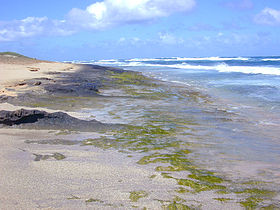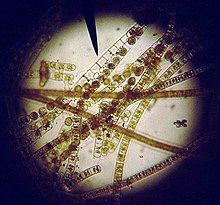Green algae: Difference between revisions
Margin1522 (talk | contribs) m →Chemistry: table placement |
m →Physiology: Journal cites, Added 1 doi to a journal cite using AWB (10365) |
||
| Line 95: | Line 95: | ||
==Physiology== |
==Physiology== |
||
The green algae, including the characean algae, have served as model experimental organisms to understand the mechanisms of the ionic and water permeability of membranes, [[osmoregulation]], [[turgor regulation]], [[salt tolerance]], [[cytoplasmic streaming]], and the generation of [[action potentials]].<ref>{{cite journal|last=Tazawa|first=Masashi|title=Sixty Years Research with Characean Cells: Fascinating Material for Plant Cell Biology|journal=Progress in Botany|year=2010|volume=72|pages=5–34|url=http://books.google.com/books?id=iMxH0-q42PkC&pg=PA31&lpg=PA31&dq=tazawa+sixty+years&source=bl&ots=bVV6JdDv6H&sig=YQQQRxzwpFYnYTR2TR6hMvQRZDk&hl=en&sa=X&ei=Cmz8T4TmF8Lb0QGK7aSIBw&ved=0CFEQ6AEwAQ#v=onepage&q&f=false|accessdate=7-10-2012}}</ref> |
The green algae, including the characean algae, have served as model experimental organisms to understand the mechanisms of the ionic and water permeability of membranes, [[osmoregulation]], [[turgor regulation]], [[salt tolerance]], [[cytoplasmic streaming]], and the generation of [[action potentials]].<ref>{{cite journal|last=Tazawa|first=Masashi|title=Sixty Years Research with Characean Cells: Fascinating Material for Plant Cell Biology|journal=Progress in Botany|year=2010|volume=72|pages=5–34|url=http://books.google.com/books?id=iMxH0-q42PkC&pg=PA31&lpg=PA31&dq=tazawa+sixty+years&source=bl&ots=bVV6JdDv6H&sig=YQQQRxzwpFYnYTR2TR6hMvQRZDk&hl=en&sa=X&ei=Cmz8T4TmF8Lb0QGK7aSIBw&ved=0CFEQ6AEwAQ#v=onepage&q&f=false|accessdate=7-10-2012|doi=10.1007/978-3-642-13145-5_1}}</ref> |
||
==See also== |
==See also== |
||
Revision as of 14:20, 13 August 2014
| Green algae | |
|---|---|

| |
| Stigeoclonium, a chlorophyte green alga genus | |
| Scientific classification | |
| Kingdom: | Plantae |
| Groups included | |
| Cladistically included but traditionally excluded taxa | |
The green algae (singular: green alga) are the large group of algae within which the Embryophytes (higher plants) emerged in the Charophytes.[1] However, as the Embryophytes are traditionally excluded, they form a paraphyletic group, although the clade including both green algae and embryophytes is monophyletic and may be referred to as the Viridiplantae and as the kingdom Plantae. The green algae include unicellular and colonial flagellates, most with two flagella per cell, as well as various colonial, coccoid and filamentous forms, and macroscopic seaweeds. In the Charales, the closest relatives of higher plants, full differentiation of tissues occurs.[clarification needed] There are about 8,000 species of green algae.[2] Many species live most of their lives as single cells, while other species form coenobia (colonies), long filaments, or highly differentiated macroscopic seaweeds.
A few other organisms rely on green algae to conduct photosynthesis for them. The chloroplasts in euglenids and chlorarachniophytes were acquired from ingested green algae,[1] and in the latter retain a nucleomorph (vestigial nucleus). Green algae are also found symbiotically in the ciliate Paramecium, and in Hydra viridissima and in the Platyhelminthes. Some species of green algae, particularly of genera Trebouxia of the class Trebouxiophyceae and Trentepohlia (class Ulvophyceae), can be found in symbiotic associations with fungi to form lichens. In general the fungal species that partner in lichens cannot live on their own, while the algal species is often found living in nature without the fungus. Trentepohlia is a filamentous green alga that can live independently on humid soil, rocks or tree bark or form the photosymbiont in lichens of the family Graphidaceae.
Cellular structure
Green algae have chloroplasts that contain chlorophyll a and chlorophyll b, giving them a bright green color, as well as the accessory pigments beta carotene and xanthophylls,[3] in stacked thylakoids.[4] The cell walls of green algae usually contain cellulose and they store carbohydrate in the form of starch.[5]
All green algae have mitochondria with flat cristae. When present, paired flagella are used to move the cell. They are anchored by a cross-shaped system of microtubules and fibrous strands.[citation needed] Flagella are only present in the motile male gametes of charophytes[6] and are absent from the gametes of Pinophyta and flowering plants.
Members of the Chlorophyceae class undergo closed mitosis in the most common form of cell division among the green algae, which occurs via a phycoplast.>[7]
Like land plants, Charophyte green algae undergo open mitosis without centrioles. Instead, a 'raft' of microtubules, the phragmoplast, is formed from the mitotic spindle and cell division involves the use of this phragmoplast in the production of a cell plate.[8]
Origins
Photosynthetic eukaryotes originated following a primary endosymbiotic event, where a heterotrophic eukaryotic cell engulfed a photosynthetic cyanobacterium-like prokaryote that became stably integrated and eventually evolved into a membrane-bound organelle, the plastid.[9] This primary endosymbiosis event gave rise to three autotrophic clades with primary plastids: the green plants, the red algae and the glaucophytes.[10]
Evolution and classification

Green algae are often classified with their embryophyte descendants in the green plant clade Viridiplantae (or Chlorobionta). Viridiplantae, together with red algae and glaucophyte algae, form the supergroup Primoplantae, also known as Archaeplastida or Plantae sensu lato.
The Viridiplantae diverged into two clades. The Chlorophyta includes the early diverging prasinophyte lineages and the core Chlorophyta, which contain the majority of described species of green algae. The Streptophyta includes the charophytes, a paraphyletic assemblage of freshwater algae from which the land plants have evolved. Below is a consensus reconstruction of green algal relationships, mainly based on molecular data. [11][12][13][14]
The algae of this paraphyletic group "Charophyta" were included before in Chlorophyta, so green algae and Chlorophyta in this definition were synonyms.
Reproduction

Green algae are eukaryotic organisms that follow a reproduction cycle called alternation of generations.
Reproduction varies from fusion of identical cells (isogamy) to fertilization of a large non-motile cell by a smaller motile one (oogamy). However, these traits show some variation, most notably among the basal green algae called prasinophytes.
Haploid algal cells (containing only one copy of their DNA) can fuse with other haploid cells to form diploid zygotes. When filamentous algae do this, they form bridges between cells, and leave empty cell walls behind that can be easily distinguished under the light microscope. This process is called conjugation and occurs for example in Spirogyra.
The species of Ulva are reproductively isomorphic, the diploid vegetative phase is the site of meiosis and releases haploid zoospores, which germinate and grow producing a haploid phase alternating with the vegetative phase.[15]
Chemistry
| Algal group | δ13C range[16] |
|---|---|
| HCO3-using red algae | −22.5‰ to −9.6‰ |
| CO2-using red algae | −34.5‰ to −29.9‰ |
| Brown algae | −20.8‰ to −10.5‰ |
| Green algae | −20.3‰ to −8.8‰ |
The green algae span a wide range of δ13C values, with different groups having different typical ranges.
Green algae[which?] contain sulfated polysaccharides like rhamnan sulfate in the amorphous sections of their cell walls.[citation needed] Some species[which?] also contain gallotannins.[citation needed]
Physiology
The green algae, including the characean algae, have served as model experimental organisms to understand the mechanisms of the ionic and water permeability of membranes, osmoregulation, turgor regulation, salt tolerance, cytoplasmic streaming, and the generation of action potentials.[17]
See also
References
- ^ a b Jeffrey D. Palmer, Douglas E. Soltis and Mark W. Chase (2004). "The plant tree of life: an overview and some points of view". American Journal of Botany. 91 (10): 1437–1445. doi:10.3732/ajb.91.10.1437. PMID 21652302.
- ^ Guiry, M.D. (2012). "How many species of algae are there?". Journal of Phycology. 48: 1057–1063. doi:10.1111/j.1529-8817.2012.01222.x.
- ^ Burrows 1991. Seaweeds of the British Isles. Volume 2 Natural History Museum, London. ISBN 0-565-00981-8
- ^ Hoek, C. van den, Mann, D.G. and Jahns, H.M. 1995. Algae An introduction to phycology. Cambridge University Press, Cambridge. ISBN 0-521-30419-9
- ^ Judd, W.S., Campbell, C.S., Kellogg, E.A., Stevens, P.F. and Donoghue, M.J. Sinauer (2002) Plant systematics, a phylogenetic approach. Associates Inc., Sunderland Mass. ISBN 0-87893-403-0 , p156
- ^ Bhattacharya D, Medlin L (1998) Algal phylogeny and the origin of land plants" Plant Physiology 116, 9–15
- ^ J. Pickett-Heaps (1976) Cell division in eucaryotic algae. Bioscience 26 (7) 445-450
- ^ P.H. Raven, R.F. Evert, S.E. Eichhorn (2005): Biology of Plants, 7th Edition, W.H. Freeman and Company Publishers, New York, ISBN 0-7167-1007-2
- ^ Keeling, PJ (2010). "The endosymbiotic origin, diversification and fate of plastids". Philosophical Transactions of the Royal Society B: Biological Sciences. 365 (1541): 729–748. doi:10.1098/rstb.2009.0103. ISSN 0962-8436. PMC 2817223. PMID 20124341.
- ^ De Clerck, O; Bogaert, KA; Leliaert, F (2012). "Diversity and Evolution of Algae". Advances in Botanical Research. 64: 55–86. doi:10.1016/B978-0-12-391499-6.00002-5. ISSN 0065-2296.
- ^ Lewis, L. A & R. M. McCourt (2004). "Green algae and the origin of land plants". American Journal of Botany. 91 (10): 1535–1556. doi:10.3732/ajb.91.10.1535. PMID 21652308.
- ^ Leliaert, Frederik; Smith, David R.; Moreau, Hervé; Herron, Matthew D.; Verbruggen, Heroen; Delwiche, Charles F.; De Clerck, Olivier (2012). "Phylogeny and Molecular Evolution of the Green Algae" (PDF). Critical Reviews in Plant Sciences. 31: 1–46. doi:10.1080/07352689.2011.615705.
- ^ Marin, Birger (2012). "Nested in the Chlorellales or Independent Class? Phylogeny and Classification of the Pedinophyceae (Viridiplantae) Revealed by Molecular Phylogenetic Analyses of Complete Nuclear and Plastid-encoded rRNA Operons". Protist. 163: 778–805. doi:10.1016/j.protis.2011.11.004.
- ^ Laurin-Lemay, Simon; Brinkmann, Henner; Philippe, Hervé (2012). "Origin of land plants revisited in the light of sequence contamination and missing data". Current Biology. 22: R593–R594. doi:10.1016/j.cub.2012.06.013.
- ^ [1]
- ^ Maberly, S. C.; Raven, J. A.; Johnston, A. M. (1992). "Discrimination between 12C and 13C by marine plants". Oecologia. 91 (4): 481. doi:10.1007/BF00650320. JSTOR 4220100.
- ^ Tazawa, Masashi (2010). "Sixty Years Research with Characean Cells: Fascinating Material for Plant Cell Biology". Progress in Botany. 72: 5–34. doi:10.1007/978-3-642-13145-5_1. Retrieved 7-10-2012.
{{cite journal}}: Check date values in:|accessdate=(help)
